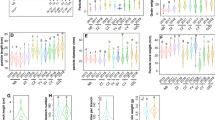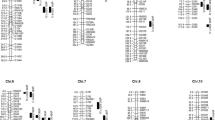Abstract
Using mixed-model-based composite interval map** and conditional statistical methods, we studied quantitative trait loci (QTLs) with epistatic effects and QTLs by environment interaction effects for rice seed set percent (SSP), filled grain number per plant (FGP), and panicle length (PL). A population of 241 recombinant inbred lines was used which was derived from a cross between “Zhenshan 97” and “Minghui 63.” Its linkage map included 221 molecular markers. Our QTL analysis detected 28, 25, and 32 QTLs for SSP, FGP, and PL, respectively. Each QTL explained 1.37%∼13.19% of the mean phenotypic variation. A comparison of conventional and conditional map** provided information about the genetic control system involved in the synthetic process of SSP, FGP, and PL at the level of individual QTLs. Conditional QTLs with reduced (or increased) effects were identified for SSP, which were significantly influenced by FGP or PL. Some QTLs could express independently for the given traits, thereby providing possibilities for simultaneous improvement of SSR and PL, and SSR and FGP. Epistasis was more sensitive to environmental conditions than were additive effects.

Similar content being viewed by others
References
Ashikari M, Sakakibara H, Lin S et al (2005) Cytokinin oxidase regulates rice grain production. Science 309:741–745
Brondani C, Rangel P, Brondani R et al (2002) QTL map** and introgression of yield-related traits from Oryza glumaepatula to cultivated rice (Oryza sativa) using microsatellite markers. Theor Appl Genet 104:1192–1203
Cao GQ (2000) QTL analysis of epistatic and conditional effects for some agronomic traits in rice (Oryza sativa L.). Ph.D. Dissertation, Zhejiang University, Hangzhou, China
Cao G, Zhu J, He C et al (2001) Impact of epistasis and QTL × environment interaction on the developmental behavior of plant height in rice (Oryza sativa L.). Theor Appl Genet 103:153–160
Fan C, **ng Y, Mao H et al (2006) GS3, a major QTL for grain length and weight and minor QTL for grain width and thickness in rice, encodes a putative transmembrane protein. Theor Appl Genet 112:1164–1171
Frary A, Nesbitt TC, Grandillo S et al (2000) Cloning and transgenic expression of fw 2.2: A quantitative traits locus key to the evolution of tomato fruits. Science 289:85–87
Guo LB, **ng YZ, Mei HW et al (2005) Dissection of component QTL expression in yield formation in rice. Plant Breed 124(2):127–132
Jiang GH, Xu CG, Li XH et al (2004) Characterization of the genetic basis for yield and its component traits of rice revealed by doubled haploid population. Acta Genet Sin 31:63–72
Lander ES, Botsein D (1989) Map** Mendelian factors underlying quantitative traits using RFLP linkage maps. Genetics 121:185–199
Li JM, Thomson M, McCouch SR (2004) Fine map** of a grain-weight quantitative trait locus in pericentromeric region of rice chromosome 3. Genetics 168:2187–2195
Li YL, Dong YB, Cui DQ et al (2008) The genetic relationship between pop** expansion volume and two yield components in popcorn using unconditional and conditional QTL analysis. Euphytica 162(3):345–351
Liu JP, van Eck J, Cong B et al (2002) A new class of regulatory genes underlying the cause of pear-shaped tomato fruit. Proc Natl Acad Sci U S A 99(20):13302–13306
McCouch SR, Cho YG, Yano M et al (1997) Report on QTL nomenclature. Rice Genet Newslett 14:11–13
Mei YJ, Ye ZH, Xu Z (2007) Genetic impacts of fiber sugar content on fiber characters in Island cotton (Gossypium barbadense L.). Euphytica 154:29–39
Moncada P, Martinez CP, Borrero J et al (2001) Quantitative trait loci for yield and yield components in an Oryza sativa × Oryza rufipogon BC2F2 population evaluated in an upland environment. Theor Appl Genet 102:41–52
Rao SA, Khan MA, McNeilly T et al (1997) Cause and effect relations of yield and yield component in rice (Oryza sativa L.). J Genet Breed 51:1–5
Septiningsih EM, Prasetiyono J, Lubis E et al (2003) Identification of quantitative trait loci for yield and yield components in an advanced backcross population derived from the Oryza sativa variety IR64 and the wild relative O. rufipogon. Theor Appl Genet 107:1419–1432
Song XJ, Huang W, Shi M et al (2007) A QTL for rice grain width and weight encodes a previously unknown RING-type E3 ubiquitin ligase. Nature Genet 39(5):623–630
Thomson MJ, Tai TH, McClung AM et al (2003) Map** quantitative trait loci for yield, yield components and morphological traits in an advanced backcross population between Oryza rufipogon and the Oryza sativa cultivar Jefferson. Theor Appl Genet 107:479–493
**ao J, Li J, Yuan L et al (1998) Identification of QTL affecting traits of agronomic importance in a recombinant inbred population from a subspecific rice cross. Theor Appl Genet 92:230–244
**ng YZ, Xu CG, Hua JP et al (2001) Analysis of QTL × environment interaction for rice panicle characteristics. Acta Genet Sin 28(5):439–446
**ng YZ, Tan YF, Hun JP et al (2002) Characterization of the main effects, epistatic effects and their environmental interactions of QTLs on the genetic basis of yield traits in rice. Theor Appl Genet 105:248–257
Yan JQ, Zhu J, He CX, Benmoussa M et al (1998b) Quantitative trait loci analysis for the developmental behavior of tiller number in rice (Oryza sativa L.). Theor Appl Genet 97:267–274
Yan JQ, Zhu J, He CX, Benmoussa M et al (1998a) Molecular dissection of developmental behavior of plant height in rice (Oryza sativa L.). Genetics 150:1257–1265
Yang J, Zhu J, Williams RW (2007) Map** the genetic architecture of complex traits in experimental populations. Bioinformatics 23:1527–1536
Yano M, Katayose Y, Ashikari M et al (2000) Hd1, a major photoperiod sensitivity quantitative trait locus in rice, is closely related to the Arabidopsis flowering time gene CONSTANS. Plant Cell 12:2473–2484
Ye ZH, Lu ZZ, Zhu J (2003) Genetic analysis for developmental behavior of some seed quality traits in upland cotton (Gossypium hirsutum L.). Euphytica 129(2):183–191
Yu SB, Li JX, Xu CG et al (1997) Importance of epistasis as the genetic basis of heterosis in an elite rice hybrid. Proc Natl Acad Sci U S A 94:9226–9231
Zhao JY, Becher HC, Zhang DQ et al (2006) Conditional QTL map** of oil content in rapeseed with respect to protein content and traits related to plant development and grain yield. Theor Appl Genet 113:33–38
Zhu J (1992) Mixed model approaches for estimating genetic variances and covariances. J Biomath 7:1–11
Zhu J (1995) Analysis of conditional genetic effects and variance components in developmental genetics. Genetics 141:1633–1639
Zhu J (1999) Mixed model approaches of map** genes for complex quantitative traits. J Zhejiang Univ (Natural Sci) 33(3):327–335
Zhuang JY, Fan YY, Rao ZM et al (2002) Analysis on additive effects and additive-by-additive epistatic effects of QTLs for yield traits in a recombinant inbred line population of rice. Theor Appl Genet 105:1137–1145
Acknowledgments
We thank Prof. Qifa Zhang for providing the map** population and linkage map. This work was supported in part by the National Key Project of Scientific and Technical Supporting Programs, funded by the Ministry of Science and Technology of China (2008BAK41B01-4); and by the Project of Wenzhou Science and Technology Bureau (N20080018).
Author information
Authors and Affiliations
Corresponding author
Rights and permissions
About this article
Cite this article
Ye, Z., Wang, J., Liu, Q. et al. Genetic Relationships Among Panicle Characteristics of Rice (Oryza sativa L.) Using Unconditional and Conditional QTL Analyses. J. Plant Biol. 52, 259–267 (2009). https://doi.org/10.1007/s12374-009-9026-x
Received:
Revised:
Accepted:
Published:
Issue Date:
DOI: https://doi.org/10.1007/s12374-009-9026-x




